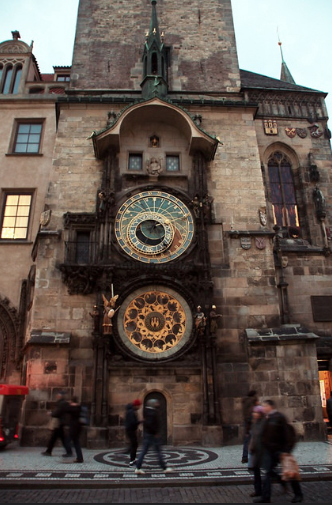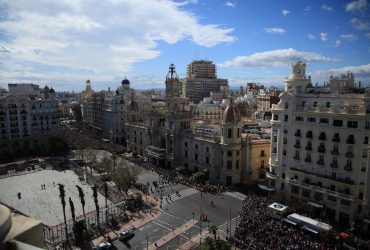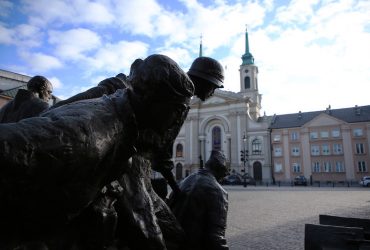Today I take you for a walk through the centre of Prague, small and easy to get around by foot (the public transports pass “outside” the area).
 I want to start this tour from Charles’ Bridge, a stone bridge (not unique, of course), of the city. This bridge links the old town to the Mala Strana district, the “castle side” of the Vltava. I must admit that it left me with a strange feeling: it was as I expected, after seeing a myriad of photos, but not entirely. But at least for a walk, you should go there, for its history: it is a symbol of the city! Under the bridge, on the side of Mala Strana (“castle side” of the Moldovan), there is a vast colony of swans.
I want to start this tour from Charles’ Bridge, a stone bridge (not unique, of course), of the city. This bridge links the old town to the Mala Strana district, the “castle side” of the Vltava. I must admit that it left me with a strange feeling: it was as I expected, after seeing a myriad of photos, but not entirely. But at least for a walk, you should go there, for its history: it is a symbol of the city! Under the bridge, on the side of Mala Strana (“castle side” of the Moldovan), there is a vast colony of swans.
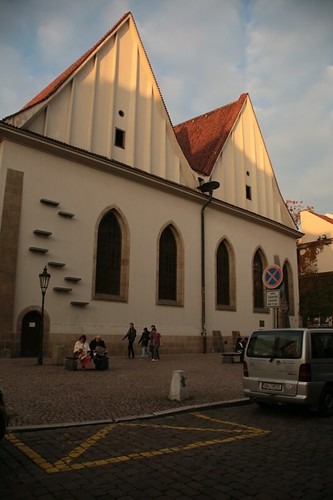 It attracts many tourists, but also families and newlyweds that are brought here for the wedding photo shoot. I must admit that me too I enjoyed feeding them. We continue our walk through the alleys of the historic city centre, streets that, in my opinion, have a magic all their own (the “magic of northern Europe”). We also pass through the Bethlehem Chapel because we wanted to visit it, but unfortunately, in those days it was closed (I was sorry a lot I could not see it). It is a small church in the district of the Staré Město erected by two Czech architects between 1391 and 1394. The hall was mostly used for sermons in Czech. The history of the Bethlehem Chapel is linked above all to the figure of Jan Hus, of which I will speak to you (again) shortly. The aspect that everyone will talk about, if you seek information, is that the chapel was destroyed to build, in its place, a three-storey house and was rebuilt by architect Jaroslav Fragner by ancient illustrations at the end of World War II. Whether you can visit it or not, then I suggest you wander through the streets of the centre without a precise destination, even if you lose yourself, because they deserve to be savoured without haste. We continue our tour up to the old town square. More significant than I expected, many of the symbols and things to see (absolutely) are concentrated in this square during a trip to Prague. I start telling you about it from the statue of Jan Hus:
It attracts many tourists, but also families and newlyweds that are brought here for the wedding photo shoot. I must admit that me too I enjoyed feeding them. We continue our walk through the alleys of the historic city centre, streets that, in my opinion, have a magic all their own (the “magic of northern Europe”). We also pass through the Bethlehem Chapel because we wanted to visit it, but unfortunately, in those days it was closed (I was sorry a lot I could not see it). It is a small church in the district of the Staré Město erected by two Czech architects between 1391 and 1394. The hall was mostly used for sermons in Czech. The history of the Bethlehem Chapel is linked above all to the figure of Jan Hus, of which I will speak to you (again) shortly. The aspect that everyone will talk about, if you seek information, is that the chapel was destroyed to build, in its place, a three-storey house and was rebuilt by architect Jaroslav Fragner by ancient illustrations at the end of World War II. Whether you can visit it or not, then I suggest you wander through the streets of the centre without a precise destination, even if you lose yourself, because they deserve to be savoured without haste. We continue our tour up to the old town square. More significant than I expected, many of the symbols and things to see (absolutely) are concentrated in this square during a trip to Prague. I start telling you about it from the statue of Jan Hus:
 very large and austere; I admit that it also put me a bit ‘of anxiety. For those who did not know who he is, Jan Hus was a theologian and a Bohemian religious reformer, as well as rector at the University of Caroline of Prague. He promoted a religious movement based on the ideas of John Wycliffe, and his followers became known as Hussites. Excommunicated in 1411 by the Catholic Church and condemned by the Council of Constance, it was burned at stake. Near the statue, there is a long brass line with, at one end, a plate bearing the inscription “The meridian based on which the time of Prague was once calculated”: that line indicates the point where the meridian of Prague passes (yes, the plate is what you see in the picture).
very large and austere; I admit that it also put me a bit ‘of anxiety. For those who did not know who he is, Jan Hus was a theologian and a Bohemian religious reformer, as well as rector at the University of Caroline of Prague. He promoted a religious movement based on the ideas of John Wycliffe, and his followers became known as Hussites. Excommunicated in 1411 by the Catholic Church and condemned by the Council of Constance, it was burned at stake. Near the statue, there is a long brass line with, at one end, a plate bearing the inscription “The meridian based on which the time of Prague was once calculated”: that line indicates the point where the meridian of Prague passes (yes, the plate is what you see in the picture).
 Not far from the city hall tower, there are 27 white crosses drawn on the sidewalk. Besides the crosses, there is the date of 21 June 1621: it refers to the day on which, in this point, 27 leaders of the Protestant uprising (27 Czech lords) were beheaded, because they were against the government of the Catholic emperor Ferdinand II. History says that it was a slow and ruthless carnage. Finally, the severed heads were placed in iron baskets and exposed on the Old Town Bridge Tower as a warning.
Not far from the city hall tower, there are 27 white crosses drawn on the sidewalk. Besides the crosses, there is the date of 21 June 1621: it refers to the day on which, in this point, 27 leaders of the Protestant uprising (27 Czech lords) were beheaded, because they were against the government of the Catholic emperor Ferdinand II. History says that it was a slow and ruthless carnage. Finally, the severed heads were placed in iron baskets and exposed on the Old Town Bridge Tower as a warning.
 We continue the tour of the square moving in front of the building of the town hall: on its tower, there is the famous Prague astronomical clock. I must say that I thought it was bigger, but despite this, I was very impressed! It has a unique mechanism, composed of three main elements:
We continue the tour of the square moving in front of the building of the town hall: on its tower, there is the famous Prague astronomical clock. I must say that I thought it was bigger, but despite this, I was very impressed! It has a unique mechanism, composed of three main elements:
– The “Procession of the Apostles“, a device that, every hour, puts the figures representing the 12 Apostles in motion;
– The astronomical quadrant where the positions of the Sun and the Moon are represented, besides the hour and other astronomical information;
– The lower quadrant, finally, consists of 12 medallions that symbolise (apparently) the 12 months of the year. If you want to see the figures of the apostles moving at the stroke of the hour, you must bear in mind that you will find many other tourists waiting exactly like you!
My advice is to get here as soon as possible and, above all, not to put yourself in front of the crowd: you will be very under the clock, and you will not see anything! So I suggest you stay a while back. If you want to make a video, I recommend you to stay a little on the side, near a bar that has a veranda on the square (to partially avoid, in the video, to have only the heads of people who will pass by you).
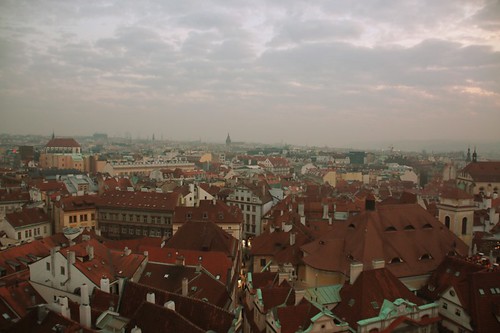 The clock is located on the facade of the Town Hall tower. This tower It has begun in 1364 in Gothic style, it is about 70 meters high, and it is possible to climb to the top, and the ticket costs 120 crowns only for the tower (160 if you want to visit also the town hall). We climbed only on the tower: it was quite late, and there was little light, so we enjoyed the view at sunset. You can choose to go up with elevator or on foot, and I suggest you take the elevator to go up and to come down on foot for one simple reason: the elevator shaft is very special and its modernity is in contrast to the ancient tower. A contradiction that deserves a fleeting glance while you wait for it to come to the top!
The clock is located on the facade of the Town Hall tower. This tower It has begun in 1364 in Gothic style, it is about 70 meters high, and it is possible to climb to the top, and the ticket costs 120 crowns only for the tower (160 if you want to visit also the town hall). We climbed only on the tower: it was quite late, and there was little light, so we enjoyed the view at sunset. You can choose to go up with elevator or on foot, and I suggest you take the elevator to go up and to come down on foot for one simple reason: the elevator shaft is very special and its modernity is in contrast to the ancient tower. A contradiction that deserves a fleeting glance while you wait for it to come to the top!
 I conclude the tour through the centre of Prague taking you for a walk to Wenceslas Square which, in fact, more than a square looks like a giant avenue with a pedestrian area in the middle. Here you can see the magnificent building of the National Museum; you will surely recognise it. This square is a place of memory for the city:
I conclude the tour through the centre of Prague taking you for a walk to Wenceslas Square which, in fact, more than a square looks like a giant avenue with a pedestrian area in the middle. Here you can see the magnificent building of the National Museum; you will surely recognise it. This square is a place of memory for the city:
First of all, on October 28, 1918, was declared the independence of Czechoslovakia from the Austro-Hungarian Empire.
Then on January 16, 1969, Jan Palach burned itself in protest against the socio-cultural oppression by the Soviet Union on its own country (from this episode has begun the movement remembered as the “Spring of Prague”.
So, this is a square significant at the historical level: at least a small walk, at least one look, I think it is a must. Many shops are overlooking the square, and the people who walk along the sidewalks are very crowded.
The tour that I wanted you to do in the centre of Prague ends here. I leave you, however, with the video – story of this tour in case you wanted to see some more images of the places I have spoken to you.
Discovering Prague city centre
